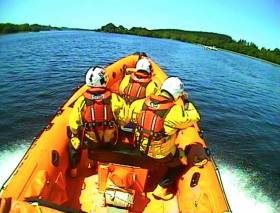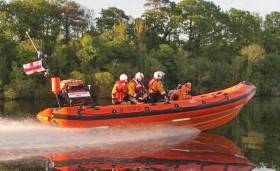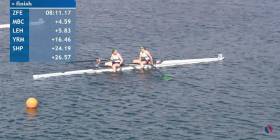Displaying items by tag: Enniskillen
#Rowing: Commercial won a stunningly-close race to take the men’s senior eights title at the Irish Rowing Championships today. NUIG/Queen’s had a slight lead ahead of a tightly-packed field early on, but Commercial moved at the 1,000 metres. They could not shake off UCD and the NUIG/Queen’s composite. UCD
finished really fast and almost – but not quite – caught Commercial, who were taking their third consecutive title.
The women’s senior eight went to Skibbereen. Their talented crew, stroked by Denise Walsh, had a clearwater lead over NUIG, who did not give up the fight but finished second. Skibbereen lifted their title haul to eight with the win.
Enniskillen started the evening session with two wins, in the women’s club eight, where Shandon pushed them, and the men’s junior pair, who were imperious in their victory.
The women’s junior coxed quadruple from Workmen’s was similarly impressive – the quality of junior rowing was a remarkable aspect of this regatta.
Another notable aspect was the proportion of wins which went to Cork clubs. Two of the last three titles did not leave the rebel county: UCC finished out their successful programme with a win in the men’s intermediate double through Ronan Byrne and Hugh Sutton, while Selma Bouanane took the last race of the event, the women’s intermediate single, for Fermoy.
Irish Rowing Championships, Day Three (Selected Results)
Men
Eight – Senior: 1 Commercial (S Mac Eoin, C Cunningham, L Cameron, N Beggan, P Moreau, F Groome, M Corcoran, C Dowling; cox: M Crockett) 5:43.18, 2 UCD 5:43.76, 3 NUIG/Queen’s 5:46.82.
Four – Club, coxed: UCC A 6:38.03.
Pair – Inter: Shandon A 6:56.07. Junior: Enniskillen 6:56.199.
Sculling, Double – Inter: UCC 6:32.59. Junior: Castleconnell (R O’Neill, J Desmond) 6:49.97.
Lightweight Single: Skibbereen (A Burns) 7:20.56.
Women
Eight – Senior: 1 Skibbereen (L Heaphy, O Hayes, M Piggott, A McCarthy, N Long, N Casey, A Casey, D Walsh; cox: A O’Neill) 6:28.42, 2 NUIG A 6:33.32, 3 Trinity 6:48.35. Club: Enniskillen 6:48.33.
Four – Inter, coxed: Cork 7:22.36.
Pair – Junior: Fermoy (E O’Reilly, G McGirr) 7:48.69.
Sculling, Quadruple – Junior: Workmen’s 7:01.06.
Single – Inter: Fermoy (S Bouanane) 8:03.25.
Lightweight Single: 1 Lee (M Cremen) 8:06.97
Championship Records Tumble at National Rowing Centre
#Rowing: Records fell in race after race in the final Saturday session of the Irish Championships. The Skibbereen senior quadruple of Fintan McCarthy, Aodhan Burns, Kealan Mannix and Jake McCarthy smashed the Championship best of 5:59.10 as they won in 5:50.696.
The Shandon junior quadruple of Eoin Gaffney, Luke Hayes-Nally, Jack Dorney and Alex Byrne – all set to compete at the World Junior Championships – set a new time of 5:58.26. This beat the old Championship record of 6:07.97.
In both cases the crews were bettering times set by their own club.
Lisa Dilleen’s win in the women’s senior single scull was emphatic. The Cork Boat Club sculler set a Championship course record of 7:34.282, bettering Monika Dukarska’s time of 7:35.07.
Ronan Byrne of UCC took the intermediate single, under some pressure from Niall Beggan of Commercial. Byrne’s time of 6:55.898 bettered Kealan Mannix’s time of 7:03.51, set last year.
Enniskillen took the women’s junior eights, in 6:30.753, bettering their own time from last year of 6:36.24.
In the women’s senior pair, Aine McCarthy and Niamh Casey shattered the old Championship record of 7:23.78, setting a new time of 7:17.176.
Joan Poh of Neptune also won the club single sculls in a new record. The old figure was 8:09.22. Poh won in 8:06.13.
UCD continued their fine run in eights by adding the men’s novice title to the intermediate one.
Irish Championships, Day Two (Selected Results)
Men
Eight – Inter: UCD 5:43.70. Novice: UCD 6:03.599.
Four – Junior, coxed: Enniskillen 6:22.66.
Sculling, Quadruple – Senior: Skibbereen 5:50.696. Jun: 1 Shandon 5:58.26
Single – Inter: UCC (R Byrne) 6:55.898. Club: Carlow (F O’Driscoll) 7:25.3.
Women
Eight – Novice: Queen’s 7:04.49. Jun: Enniskillen 6:30.75.
Pair – Senior: Skibbereen 7:17.18.
Sculling, Double – Inter: Skibbereen 7:09.09. Single – Senior: Cork BC (L Dilleen) 7:34.28. Club: Neptune (J Poh) 8:06.1. Jun: Coleraine GS (M Curry) 7:53.46.
Enniskillen Lifeboat Rescues Two After Boat Fire
#RNLI - Enniskillen RNLI brought two people to safety on Wednesday afternoon (4 July) after their boat they were on showed signs of catching fire.
The two people on board quickly used their fire extinguishers while also phoning 999 to ask for the coastguard.
Belfast Coastguard quickly requested the launch of Enniskillen’s inshore lifeboat Joseph and Mary Hiley, which launched with the rescue water craft to the casualty vessel close to Castle Cauldwell, three miles east of Belleek in Co Fermanagh.
On arrival, Enniskillen RNLI were joined by a passing vessel offering assistance. Conditions at the time were warm and calm and no wind.
The volunteer crew checked that the casualty boat and the owners had extinguished the source of the fire and carried out necessary precautions.
The lifeboat set up a towline and brought the boat and passengers to Magho jetty, where they were met by Northern Ireland Fire and Rescue Service personnel based in Belleek. The boat was checked over again and all were satisfied that the fire was well extinguished.
Following the callout, Enniskillen RNLI helm Adrian Kelly said: “We were happy to assist the vessel back to Magho jetty after the owner had safely deployed his fire extinguishers and prevented serious damage.
“It was encouraging to see that the vessel had adequate safety equipment on board.”
Elsewhere, Dun Laoghaire RNLI responded to a jetskier when his engine failed in Scotsman’s Bay on Tuesday evening (3 July).
The request to launch came in at 7pm after a member of the public alerted the coastguard.
The lifeboat crew of three on Dun Laoghaire’s in-shore lifeboat successfully towed the jetskier safely back to Dun Laoghaire Harbour.
Commenting after the callout, Dun Laoghaire RNLI helm Alan Keville said: “‘It was great to see the jet skier was wearing a lifejacket but he had no means of alerting the coastguard himself. It is essential to always carry a means of communication.”
Enniskillen Lifeboat Rescues Two After Boat Breaks Free From Jetty During Storm Hector
#RNLI - Enniskillen RNLI rescued two people on Lower Lough Erne after their 42ft cruiser broke free from its jetty during Storm Hector yesterday morning (Thursday 14 June).
Belfast Coastguard requested the launch of the inshore lifeboat at 6.42am, with the volunteer crew proceeding north to the stricken vessel close to the shoreline south of Rossigh.
With increasing winds through the night, the vessel had broken free from its mooring and some of the jetty was still secured to the boat.
The winds were starting to settle but they were estimated to be Force 6 or 7 when launching from the Lough Erne Yacht Club.
The lifeboat managed to refloat the vessel and brought it into safer water. The hire company then took charge of the cruiser with the lifeboat accompanying them to a sheltered location.
“With challenging conditions this morning the crews training was put into action and brought the two people and vessel to safety,” said Gary Jones, Enniskillen RNLI’s lifeboat operations manager.
Elsewhere, pagers sounded across the Irish Sea at Holyhead RNLI just after midnight on Thursday in the midst of the storm, with reports of an 18-metre yacht with mechanical failure west of the Skerries lighthouse off Anglesey.
At the scene, the lifeboat crew found the 60-tonne vessel, with two on board, had lost all power and was struggling to cope with the weather conditions, including southerly gale-force winds and spring tides.
The lifeboat undertook a tow of the stricken yacht, which was returning from the Isle of Man TT races back to her mooring at Holyhead. Both vessels arrived safely in port at 4.30am.
Speaking on behalf of Holyhead RNLI, press officer Vicki Owens said: “The weather was unseasonably rough, but our dedicated crew left their beds to help someone in trouble.”
The surprise Storm Hector was also responsible for blowing a yacht ashore on the Kerry coast, as previously noted on Afloat.ie.
Water Activity Zone Coming To Enniskillen Blueway
#InlandWaters - That new Enniskillen Blueway water activity zone located beside Erneside footbridge will be opening soon.
A range of family-friendly water activities including canoeing, kayaking and stand-up paddle boarding will be offered at the zone developed by Waterways Ireland with the support of Fermanagh & Omagh District Council, Fermanagh Lakeland Tourism and Enniskillen BID.
If you would prefer to captain your own boat and enjoy a leisurely experience around Ireland’s only island town, you might be more interested in one of the ‘wee red boats’ from Erne Boat Hire.
There is also a new heritage boat tour taking in the monastic and heritage sites around Enniskillen including Devenish Island, and the Erne Water Taxi for a more exhilarating blast around Lough Erne.
Waterways Irelad hopes the new water activity zone will play a role in encouraging young people to access the water, engage in water sports and make a connection with Lough Erne.
The activity zone also forms part of ongoing blueway developments on Lough Erne, the first of which will be a canoeing trail from Bellanaleck to Troy, taking in Enniskillen town and the new activity zone.
Carrybridge Lifeboat Rescues Cow In Distress
#RNLI - Just two days before Carrybridge RNLI’s new inshore lifeboat had its naming ceremony, boat and crew launched to assist a cow that had fallen from a steep bank on Upper Lough Erne.
The lifeboat and rescue water craft launched at 3.30pm on Thursday afternoon (7 June) arrived to the cow and its owner, who had been trying to recover the animal from the Arney River without success.
Weather conditions had southerly Force 2 winds, with good visibility and cloudy skies.
After speaking with the farmer, the volunteer crew kept the animal close to the bank and helped to steer the cow towards a part of the bank where it would be able to get out.
After some careful coaxing, the cow was assisted in getting out of the river by the crew and the farmer’s family. The crew were thanked by the owners and the lifeboat and rescue water craft departed the scene at 4.14pm.
Then on returning to station, the RNLI crew were requested to aid a vessel which had broken down nearby. The crew assisted in towing this boat back to its private slipway.
“We are always happy to help the local community in situations where there is risk to both the public and animals,” said Tom Bailey, lifeboat operations manager at Carrybridge RNLI.
“We also advise everyone working close to the edge of water to take the necessary precautions. In this instance we were delighted that the cow was able to be recovered without injury.”
Elsewhere, Enniskillen RNLI launched yesterday afternoon (Saturday 9 June) to assist a 23ft Bayliner that has lost engine power at the entrance into the River Erne which leads to Belleek.
The charity’s inshore lifeboat Joseph and Mary Hiley and rescue water craft arrived at the casualty vessel which had three people onboard, all of whom were safe and well.
The volunteer crew set up a tow to the lifeboat and towed the vessel to Aughinver.
Speaking following the callout, Enniskillen RNLI helm Aidy Kelly said: “It was a very successful recovery with our crew using the benefits of their winter training to recover the vessel and all onboard safely to Aughinver.”
Fermoy, Enniskillen and Bann Take Golds, Silver and Bronze at National Schools' Regatta
#Rowing: Irish crews took a full set of medals – gold, silver and bronze – in Championship finals on another excellent day at the British National Schools’ Regatta on Dorney Lake on Sunday. The Fermoy pair of Ellie O’Reilly and Gill McGirr powered away from their opponents in the second half of the Championship Pair A Final, while Enniskillen’s Nathan Timoney and Odhran Donaghy took a comfortable second in the men’s race. Aaron Christie of Bann held out well to hold on to third in the Championship Singles. Enniskillen also took a gold medal in the junior 16 girls’ pair, through Zoe McCutcheon and Maeve Donnelly.
British National Schools’ Regatta, Dorney Lake (Selected Results; Irish interest)
Saturday
Boys
Championship/Non-Championship Eight – B Final: 3 Enniskillen RBC.
Girls
Championship/Non-Championship Eight – B Final: 2 Galway 7:35.72; 3 St Michael’s 7:45.46.
Junior 16 Four, coxed – A Final: 2 Enniskillen RBC 8:22.68.
Sculling, Double – Championship A Final: 2 Workmen’s (A O’Donoghue, C Browne) 8:06.37.
Single – Championship A Final: 7 Workmen’s (C Moynihan) 9:10.40. B Final: 1 Coleraine Grammar School (M Curry) 8:43.03.
Sunday
Boys
Championship Pair: 2 Enniskillen (O Donaghy, N Timoney) 7:19.06.
Sculling, Championship Singles: 3 Bann (A Christie) 7:39.46.
Girls
Championship Pair: 1 Fermoy (E O’Reilly, G McGirr) 8:11.17.
Junior 16 Pair: 1 Enniskillen (M Donnelly, Z McCutcheon) 8:08.80
#Rowing: The Workmen’s junior women’s double took a silver at the National Schools’ Regatta at Dorney Lake in England today. In the Championship Doubles, Annie O’Donoghue and Ciara Browne finished one and a half lengths down on Latymer Upper School. Ciara Moynihan of Workmen’s finished seventh in the A Final of the Championship Singles, while Molly Curry of Coleraine Grammar School took control of the B Final and won.
Enniskillen took silver in the Boys’ Non-Championship Eights, and their girls’ junior 16 coxed four matched them in their A Final. Ireland clubs placed second and third in the B Final of the Girls’ Championship/Non Championship Eights.
British National Schools’ Regatta, Dorney Lake (Selected Results; Irish interest)
Saturday
Boys
Championship/Non-Championship Eight – B Final: 3 Enniskillen RBC.
Girls
Championship/Non-Championship Eight – B Final: 2 Galway 7:35.72; 3 St Michael’s 7:45.46.
Junior 16 Four, coxed – A Final: 2 Enniskillen RBC 8:22.68.
Sculling, Double – Championship A Final: 2 Workmen’s (A O’Donoghue, C Browne) 8:06.37.
Single – Championship A Final: 7 Workmen’s (C Moynihan) 9:10.40. B Final: 1 Coleraine Grammar School (M Curry) 8:43.03.
Doyle Top Sculler as Sam McKeown Turns to Britain
#Rowing: The under-23 lightweight pair of David O’Malley and Shane Mulvaney were the most emphatic of winners on the first day of the Ireland trial at the National Rowing Centre in Cork, while Philip Doyle won the men’s single sculls – in the absence of Queen’s University clubmate Sam McKeown, who has gone to the British system.
Emily Hegarty and Aifric Keogh teamed up well in a women’s pair and Monika Dukarska was untroubled in a fine win in the women’s single sculls. Sanita Puspure is overcoming a back injury and Aileen Crowley, who has partnered Keogh in a pair, has tendonitis. Denise Walsh has tonsilitis.
Andrew Goff was the best of a talented, ambitious, group of lightweight single single scullers.
The junior ranks were vibrant and drew praise from Ireland high performance director Antonio Maurogiovanni. Fermoy’s Eliza O’Reilly and Gill McGirr confirmed their preeminence in the women’s pair, while Enniskillen’s Odhran Donaghy and Nathan Timoney were the best junior men’s pair. Aoibhinn Keating of Skibbereen was the top junior women’s sculler and Jack Dorney looked strong as he raced away to win the junior men’s single.
Ireland Assessment, National Rowing Centre (Selected Results; senior results not published)
Men – Junior
Pair – A Final: 1 O Donaghy, N Timoney (Enniskillen) 7:30.94, 2 S O’Neill, W Ronayne (Shandon) 7:36.03, 3 O’Donovan, Mulready (Castleconnell) 7:48.19. B Final: P Murphy, J Kennedy (Enniskillen) 7:48.76. Single – A Final: 1 J Dorney (Shandon) 7:45.34, 2 J Keating (Carlow) 7:53.06, 3 A Byrne (Shandon) 7:54.13. B Final: T Murphy (Lee) 8:00.55.
Women - Junior
Pair – A Final: 1 E O’Reill, G McGill. Single – A Final: 1 A Keating (Skibbereen) 8:46.75, 2 R Carson (Bann) 8:50.84, 3 C Moynihan (Workmen’s) 8:54.71. B Final: C O’Brien (Castleconnell) 8:46.50.
#Rowing: Jack Dorney was an impressive winner of the Junior 18 men’s single sculls final at the Ireland Assessment at the National Rowing Centre today. The Shandon man moved into a clear lead by the 1500 metre mark and won well from Jack Keating of Carlow, who finished well.
Odhran Donaghy and Nathan Timoney of Enniskillen won the Junior men’s pairs final from Sam O’Neill and William Ronayne of Shandon, who gave them a good battle to the line.
The Fermoy women’s junior pair of Gill McGirr and Eliza O’Reilly also won well in the women’s junior pair, while Aoibhinn Keating of Skibbereen won an exciting final of the Junior women’s single.

































































